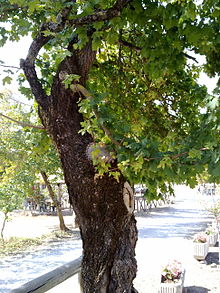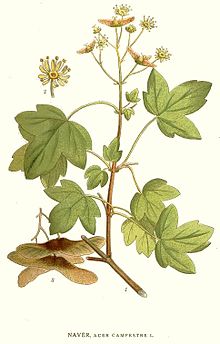Acer campestre
| Acer campestre | |
|---|---|

| |
| Scientific classification | |
| Kingdom: | Plantae |
| Clade: | Tracheophytes |
| Clade: | Angiosperms |
| Clade: | Eudicots |
| Clade: | Rosids |
| Order: | Sapindales |
| Family: | Sapindaceae |
| Genus: | Acer |
| Section: | Acer sect. Platanoidea |
| Species: | A. campestre
|
| Binomial name | |
| Acer campestre | |

| |
| Distribution | |
| Synonyms[1] | |
|
List
| |

Acer campestre, known as the field maple,
Description
It is a
The two
- Acer campestre var. campestre - downy fruit
- Acer campestre var. leiocarpum (Opiz) Wallr. (syn. A. campestre subsp. leiocarpum) - hairless fruit
The closely related Acer miyabei replaces it in eastern Asia.[3]
Distribution
The
Ecology
Field maple is an intermediate species in the
Diseases include a leaf spot fungus Didymosporina aceris, a
Cultivation
The field maple is widely grown as an
It is locally naturalised in parts of the United States[11] and more rarely in New Zealand.[18] The hybrid maple Acer × zoeschense has A. campestre as one of its parents.[4]
The tree has gained the Royal Horticultural Society's Award of Garden Merit.[19][20]
Cultivars
Over 30
- 'Carnival'
- 'Commodore'
- 'Compactum'
- 'Eastleigh Weeping'
- 'Elegant'
- 'Elsrijk'
- 'Evenly Red'
- 'Fastigiatum'
- 'Green Weeping'
- 'Leprechaun'
- 'Lienco'
- 'Marjolein'
- 'Nanum'
- 'Pendulum'
- 'Postelense'
- 'Pulverulentum'
- 'Punctatissimum'
- 'Puncticulatum'
- 'Queen Elisabeth'
- 'Red Shine'
- 'Royal Ruby'
- 'Ruby Glow'
- 'Schwerinii'
- 'Senator'
- 'Silver Celebration'
- 'Silver Dawn'
- 'Streetwise'
- 'Tauricum'
- 'Tomentosum'
- 'William Caldwell'
- 'Zorgvlied'
Bonsai
Acer campestre (and the similar
Gallery
-
Field maple leaf
-
Leaves and flowers
-
Field maple, Germany
-
Leaves
-
Foliage in spring
-
Field maple, Hesse, Germany
-
Field maple leaf
-
Fruits
-
Field maple
-
Field maple flowers
-
Field maple in autumn, France
-
Field maple, Germany
-
Field maple, Spain
-
Leaves and inflorescence
-
Leaves and fruits
-
Trunk
-
Maple field tree, Weinsberg
-
Leaf
References
- ^ "Acer campestre L." Plants of the World Online. Board of Trustees of the Royal Botanic Gardens, Kew. 2017. Retrieved 31 July 2020.
- ^ BSBI List 2007 (xls). Botanical Society of Britain and Ireland. Archived from the original (xls) on 2015-06-26. Retrieved 2021-03-03.
- ^ ISBN 0-00-220013-9.
- ^ ISBN 0-00-212035-6
- ^ a b Euro+Med Plantbase Project: Acer campestre Archived 2007-09-28 at the Wayback Machine
- ^ "Acer campestre". Flora Europaea. Retrieved August 29, 2007.
- ^ Flora of NW Europe: Acer campestre[permanent dead link]
- ^ Den virtuella floran: Acer campestre distribution map
- ^ a b Nagy, L.; Ducci, F. (2004). "Acer campestre - Field maple" (PDF). EUFORGEN Technical Guidelines for Genetic Conservation and Use: 6 p. Archived from the original (PDF) on 2016-10-19.
- ^ "Online atlas of the British and Irish flora, Acer campestre (Field maple)". Biological Records Centre and Botanical Society of Britain and Ireland.
- ^ a b "Acer campestre". USDA Plants Profile. Retrieved August 29, 2007.
- ^ "Acer campestre". Ohio State University. Archived from the original on September 1, 2006. Retrieved August 29, 2007.
- ^ Department of Agriculture, Western Australia: Pests and Diseases Image Library Archived 2008-08-19 at the Wayback Machine
- ^ Wright, Joseph. The English dialect dictionary. Vol. 6. London: Oxford University Press. p. 109.
- ^ "Field maple images and diseases". Archived from the original on 2007-09-28. Retrieved 2007-08-29.
- ^ "Field maple_Woodland Trust". Archived from the original on 2010-09-13. Retrieved 2010-08-24.
- ISBN 1580081665.
- ^ Trans. and Proc. Roy. Soc. New Zealand 36: 203-225 Plants naturalised in the County of Ashburton
- ^ "Acer campestre". www.rhs.org. Royal Horticultural Society. Retrieved 27 February 2020.
- ^ "AGM Plants - Ornamental" (PDF). www.rhs.org. Royal Horticultural Society. November 2018. p. 1. Retrieved 27 February 2020.
- ^ van Gelderen, C.J.; van Gelderen, D.M. (1999). Maples for Gardens: A Color Encyclopedia.
- ^ "A. campestre". Bonsai Club International. Archived from the original on November 11, 2006. Retrieved November 26, 2006.
- ^ D'Cruz, Mark. "Ma-Ke Bonsai Care Guide for Acer campestre". Ma-Ke Bonsai. Archived from the original on March 15, 2012. Retrieved April 15, 2011.
Further reading
- Chybicki, Igor J.; Waldon-Rudzionek, Barbara; Meyza, Katarzyna (December 2014). "Population at the edge: increased divergence but not inbreeding towards northern range limit in Acer campestre". Tree Genetics & Genomes. 10 (6): 1739–1753. .


















